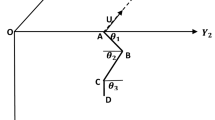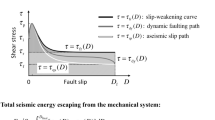Summary
An explicit expression is derived for the body force, magnetic moment and heat source to be applied in the absence of a dislocation to produce a radiation pattern identical to that of a dislocation. These quantities depend only on the fault mechanism and the material properties of the medium in the immediate vicinity of the fault. The theory is developed for dislocations in an anisotropic inhomogeneous thermo-elastic medium that exhibits pyromagnetic and piezomagnetic properties. The magnetic moment equivalent, that completely describes the magnetical effects of the dislocation, is found to be dependent on the discontinuities of the disllacement prescribed across the fault, through the piezomagnetic coefficients. Discontinuities in the thermal field and its derivatives do not contribute to the magnetic moment equivalent, thus leading to the conclusion that pyromagnetism cannot produce magnetic effects.
Russsunto
Si ottiene l'espressione esplicita della forza di massa del momento magnetico e della sorgente di calore da applicare in assenza di una dislocazione che produca una radiazione identica a quella prodotta dalla dislocazione stessa. Queste grandezze dipendono solo dal meccanismo di faglia e dalle proprietà materiali del mezzo nelle immediate vicinanze della faglia. La teoria è sviluppata per dislocazioni in un mezzo termoelastico anisotropo e non omogeneo che esibisce proprietà piromagnetiche e piezomagnetiche. Si trova che il momento magnetico equivalente che descrive completamente gli effetti magnetici della dislocazione dipende dalla discontinuità dello spostamento prescritta sulla faglia, attraverso i coefficienti piezomagnetici. Le discontinuità nel campo termico e nelle sue derivate non contribuiscono al momento magnetico equivalente, portando così alla conclusione che il piromagnetismo non può produrre effetti magnetici.
Резюме
Выводится точное выражение для объемной силы, магнитного момента и теплового источника. Полученное выражение в отсутствии дислокаций применяется для образования диаграммы излучения, идентичной диаграмме с дислокацией. Эти величины зависят только от механизма повреждения и материальных свойств средЫ в непосредственной окрестности повреждения. Развивается теория дислокаций в анизотропной неоднородной термоупругой среде, которая обнаруживает пиро- и пьезомагнитные свойства. Обнаружено, что эквивалент магнитного момента, которЫй полностью описЫвает магинтнЫе эффектЫ дислокации, зависит от разрывов смещения, заданных на повреждении, через пьезомагнитные козффициенты. Разрывы в температурном поле и его производных не дают вклада в эквивалент магнитного момента, что приводит к утверждению, что пиромагнетизм не может вызывать магнитных эффектов.
Similar content being viewed by others
References
T. Rikitake:Tectonophysics,6, 59 (1968).
M. J. S. Johnston andF. D. Stacey:Nature,224, 1289 (1969).
F. D. Stacey andB. K. Banerjee:The Physical Principles of Rock Magnetism (London and New York, N. Y., 1974).
F. D. Stacey:Adv. Phys.,12, 45 (1963).
F. D. Stacey:Pure Appl. Geophys.,58, 5 (1964).
J. P. Pozzi:Phys. Earth Planet. Inter.,14, 77 (1977).
F. D. Stacey:Physics of the Earth (New York, N. Y., 1977).
R. Burridge andL. Knopoff:Bull. Seismol. Soc. Am.,54, 1875 (1964).
M. M. Schieber:Experimental Magnetochemistry (Amsterdam, 1967).
A. S. Borovik-Romanov:Sov. Phys. JETP,9, 1390 (1959).
I. E. Dzialoshinskii:Sov. Phys. JETP,33, 807 (1957).
S. Bhagavantam:Crystal Simmetry and Physical Properties (London and New York, N. Y., 1966).
A. P. Gracknell:Magnetism in Crystalline Materials (London, 1975).
E. Boschi:Journ. Geophys. Res.,78, 7733 (1973).
L. Knopoff:Journ. Geophys. Res.,60, 441 (1955).
Y. C. Fung:Foundations of Solid Mechanics (Englewoos Cliffs, N. J., 1965).
W. Nowacki:Proceedings of the Vibration Problems (Warsaw, 1965), p. 46.
A. G. Gangi:Journ. Geophys. Res.,75, 2088 (1970).
L. D. Landau andE. M. Lifshitz:Electrodynamics of Continuous Media (London and New York, N. Y., 1960).
F. Gilbert:Geophys. Journ. R. Astron. Soc.,22, 223 (1970).
I. E. Dzialoshinskii: Dissertation, Moscow (1957).
T. Moriya:Journ. Phys. Chem. Solids,11, 73 (1959).
T. Wiss:Pageoph.,113, 297 (1973).
M. Ohnaka andH. Kinoshita:Journ. Geomagn. Geoelectr.,20, 93 (1968).
F. A. Dahlen:Bull. Seismol. Soc. Am.,62, 1173 (1972).
M. Wiss:Geophys. Journ. R. Astron. Soc.,31, 341 (1973).
M. Wiss andJ. N. Brune:Journ. Geophys. Res.,73, 4681 (1968).
Author information
Authors and Affiliations
Rights and permissions
About this article
Cite this article
Sabadini, R., Bonafede, M. & Boschi, E. A thermomagnetoelastic model of the earthquake source mechanism. Il Nuovo Cimento C 1, 523–538 (1978). https://doi.org/10.1007/BF02510111
Received:
Published:
Issue Date:
DOI: https://doi.org/10.1007/BF02510111




